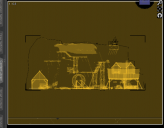How do I use a .obj file?
I bought a medieval quarry over at renderosity. However that's an .OBJ file, and I've no clue how I'm supposed to install/use it (in fact I'm not even sure it works in DAZ. Some at least of the similar assets sold by this vendor do, so I tried my luck).
After failing to find the thing in my library, I searched and read that .OBJ file are to be imported instead of loaded, so I imported the .OBJ file ("file"/ "import"). The picture shows what I got. I can't see this image from closer, nor move it, nor rotate it, etc...
Then I tried to add the textures. They come as files titles object bump, object part, object txt. I tried to import them, but it didn't seem to work. I then tried to add them to the surfaces, but it didn't seem to work either.
So, how am I supposed to use such files?




Comments
Message deleted (asking another question I found the answer to)
File>Import, you need to choose the correct preset in the option dialogue which may take some experimentation. An imported OBJ will not have moving parts, if it is grouped you can turn it into a figure fairly easily.
To add textures (and adjust other material properties) use the Surfaces pane's Editor tab - you can use the Surface selection tool to select the surface groups on the model, or select them from the list in the Surfaces pane, then click the icon to the elft of the colour pciker/strength slider for the property you want o edit to get a menu including Browse (for importing a new image) as well as a list of all loaded textures.
Well, I wasn't trying to move any part, but simply to move the whole object, so that I could have a closer view, or make it rotate, for instance. Would turning it into a figure allow me to do that? If so, how do I turn it into a figure?
Regarding the textures, that's what I tried to do, and it didn't seem to change anything (but then again I can only see the object as a distant black shape, so I might have not noticed it working).
I can't think why the model wouldn't be movable. if the textures are not applying it may not be UV mapped - though it looks as if this is the model by Dante78, which says it is mapped.
In fact, the textures do apply. I was doing it wrong. But there are still weird things (look at the picture, some elements are applied on the back of the object). I can also make the object rotate. What I still can't do is moving it (for instance zooming on it). It stays wherever it appeared. And if I add something to the scene (figure or light), I can't find it anymore. I can't find it by looking around, and I can't find it by using the command that centers on the selected object either (if I do the later, I end up watching at a black screen). I can see it only as long as I don't change my point of view, basically. If I do, I can't manage to find it again.
When you try centering the view on a selected figure/light and end up looking at a black screen, I wonder if the camera has centered on the object but you are looking at an unlit wall or other part of the quarry model between 'you' and the selected object? What do you see if you switch to the other views - front, top, left, right, back etc. and center them on the selected figure or light?
When trying to zoom or move the quarry model, perhaps that is huge and so it just looks like it's not moving/zooming because the steps DS is moving/zooming in are tiny compared to the model's scale. (If the size of the horse is the same size of a Daz Horse, the whole thing is huge.) Have you tried entering values in the X Translate parameter, for example, perhaps progressively larger ones to see if they model moves along the X axis? Also, what if you tried creating a new camera at world center, selecting that view and rotating it, do you see anything?
I see on Rendo product page that there is a Readme file for this product, which may or may not help you, and there are some comments in the Reviews section about the packaging.
Which preset did you use in the OBJ import dialogue box?
I tried two very different : I think one unit for 8 feet and one unit for something vastly smaller.
I'm going to try to try everything that andya proposes.
OK, so it was indeed a matter of scale. I couldn't move the object when I picked 1 unit= 8 feet (I assumed it was probably intended for poser), and could only make it rotate the second time around when I picked some other scale (although while I can understand why it looked like it wasn't moving when using a very wrong scale, I don't understand why a wrong scale would prevent it from rotating). 1 unit = 1 cm worked and I could make it move/move around it normally (I could verify that it still wasn't the proper scale, but at least in the correct range).
I suspect that the black screen and my inability to see the object when I centered on a figure/light was because they were *inside* the object.
To be able to apply the textures, I apparently also needed to uncheck "read material library" while leaving "read surfaces" checked in the import options. I'd like to understand why. What does it mean when you check/uncheck the various options : "read UV coordinates", "read groups", "read surfaces" "read material libraries"?
Thank you both.